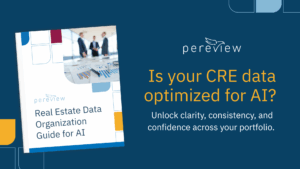We need to talk about dirty data.
This provocative couplet – referring to data that is inaccurate, incomplete, or out-of-date – represents a significant liability for real estate investment firms, regardless of property type.
When dirty data enters the asset lifecycle, particularly in the early stages like acquisition and underwriting, it is passed from stage to stage, all the way to the investor. Siloed processes and non-integrated software enable and exacerbate its spread, particularly spreadsheet software like Microsoft Excel. Considering that roughly three in every four commercial real estate firms rely on spreadsheets to store critical data – meaning they have no single source of truth – this is not a small problem.
In this post, we’re going to highlight four ways that dirty data can disrupt real estate reporting, and then share a solution that can help eliminate your data integrity issues for good.
4 Ways Dirty Data Can Disrupt Real Estate Reporting
1. Time is Money
Monthly and other regular reporting chores are painful enough for real estate firms – just imagine what a pain reporting can be when you have dirty data? Having to reconcile faulty numbers takes time – by some client estimates, we’re talking upwards of 300 to 400 hours per quarter.
2. Rising Headcounts
Not only does dirty data cost you in terms of time spent reporting, but there can also be significant personnel costs, as well. Bad data takes a lot of time and many hands to sort through – and as assets under management grow, firms with bad data invariably see a rise in headcount to deal with the influx of even more data. That vicious cycle cuts into profit margins and stretches staff resources.
3. Risky Business
Dirty data increases operational risk, as more and more staff are looped into proprietary, siloed processes. If a critical data trove is siloed within the underwriting team and a key member of that team quits, that’s – well, that’s really bad.
4. Sorry, Wrong Number(s)
There’s another type of risk that is exacerbated by dirty data – reputational risk. If your swollen headcount and excess hours spent on reporting still can’t scrub away all of your corrupt data – there’s a good chance that data will trickle all the way down to the investor. And investors aren’t keen on receiving incomplete and/or wrong data. And you know who else isn’t keen on bad data? The government.
Dirty Data Can Disrupt Real Estate Reporting: Here’s the Solution
So, how do you solve a problem like dirty data?
It depends on your current data strategy, as well as the sources of your data. In general, preventing Dirty Data involves establishing a single source of truth, eliminating siloed processes, and integrating disparate software systems.
The team at Saxony Partners can help you solve your issues around data integrity. Lack a data governance strategy? Our consulting team can help you create and establish one. Dealing with unwieldy processes and unintegrated software? We can provide customized solutions to streamline the way you do business.
Some, particularly those in the commercial real estate software space, need a life-of-the-asset software solution. Pereview is that solution – integrating data and software from acquisition to disposition. Pereview clients have reduced the amount of time spent on regular reporting by as much as 90 percent. And most have seen their assets under management grow without impacting their overall headcount.
Interested in a plan for eliminating and preventing dirty data? Reach out to the Pereview team for a chat. Think that a life-of-the-asset management software solution is in order? Schedule a demo with the team at Pereview.
—
You can follow the latest news and thought leadership from Pereview on LinkedIn.



